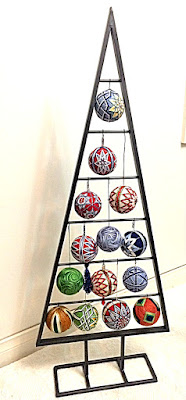I am rarely so organised to have Christmas decorations up this early. However, yesterday, I used this display stand/ Christmas tree at the Hunter Art Bazaar. Most of the handmade decorations on it were sold, so rather than put the stand away for a few weeks, I hung some of my temari balls (some made by my mother and some made by me) and here it is on the dining table already.
I must admit I thought to myself that it is far too early for Christmas decorations and I checked , on Google, of course and it appears that I am a little premature in setting up any sort of Christmas tree.
November is too early for Christmas
According to an poll carried out in 2015 by Confused.com, over 86% of people believe that November is too early to put up your decorations. So, it appears that December is the most socially acceptable time to get into the festive spirit. And if the good people of Twitter are to be believed, there are many that support this. ( from https://www.confused.com)
So another Christmas convention broken... Anyway, I rather like seeing these temari displayed like this, and even if I have been somewhat rash in setting up a tabletop metal structure which resembles a Christmas tree in November, we are going to enjoy having these stitched thread balls on show for all to admire.
If you are not familiar with temari....
Temari (手まり) balls are a folk art form and Japanese craft originating in China and introduced to Japan around 7th century A.D.[1]"Temari" means "hand ball" in Japanese. Temari are highly valued and cherished gifts, symbolizing deep friendship and loyalty. Traditionally, temari were often given to children from their parents on New Year's Day. (Wikipedia) 


Comments
Post a Comment
Thanks for reading my blog and please share your thoughts about my blog post by leaving a comment.Your comment won't appear immediately as comments are verified before publication in an effort to reduce the amount of spam appearing. Anonymous comments will not be published.